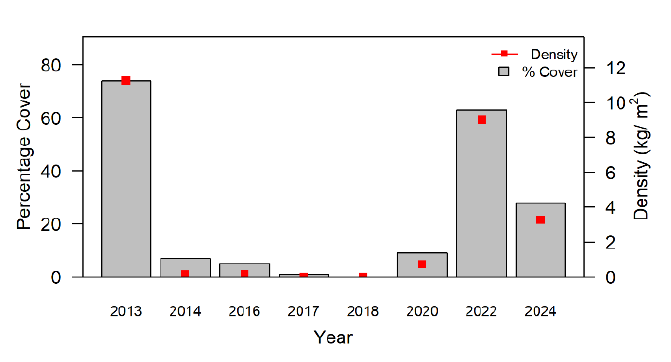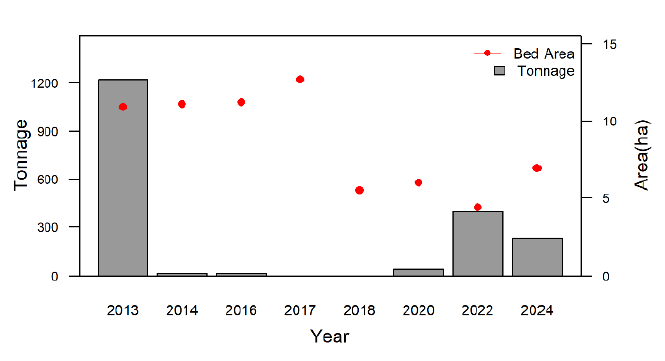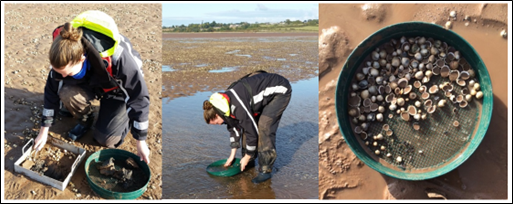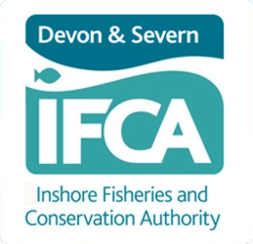D&S IFCA publishes its 2024 Exe Estuary Mussel and Cockle Stock Reports, detailing the findings of the biennial surveys, conducted in 2024.
Mussel Surveys
On 8th April 2024 D&S IFCA officers undertook a survey of the mussel beds found in the Exe Estuary, in line with D&S IFCA’s Annual Plan. This is the eighth time D&S IFCA has conducted mussel stock assessments on the Exe. Surveys began in 2013 and were initially carried out on an annual basis until 2018. Since then, surveys have been conducted biennially. Data collected from the surveys are used to build up a long-term picture of the stock status of the bed, which is used to inform management of the resource and the development of shellfisheries in this part of D&S IFCA’s District. The stock assessments now focus on the public fishery beds of Bull Hill.
The mussel beds are important as a food source supporting a range of bird species. For example, several thousand oystercatchers overwinter on the Exe Estuary and predominantly feed on the mussels. Oystercatchers and other birds in the waterbird assemblage are protected features of the Exe Estuary Special Protection Area (SPA). D&S IFCA’s survey data and reports are available to Natural England to support their upcoming Condition Assessment for the Exe Estuary SPA. The data may help Natural England to assess whether the food resources within the Exe Estuary are sufficient to support the overwintering bird population.
D&S IFCA introduced a temporary closure (relating only to mussel), from 1st May 2019 on the public shellfish beds in the Exe Estuary due to stocks of mussel in these areas being severely depleted. The chart defining the temporary closure was updated in July 2023 and can be viewed here.
What are the results from the survey?
- The 2024 Exe Estuary Mussel Stock Assessment Report can be read here
A total of 16 samples were collected from Bull Hill and the surveyed area contained an estimated 227 tonnes of mussel compared to 395 tonnes in 2022, an apparent decrease of 43%. The surveyed area appears to have decreased in density and percentage cover since 2022.


Apparent Stock Decline 2022-2024
The area surveyed at Bull Hill Bank in 2024 was larger than that surveyed in 2022, but due to a lack of staff the survey effort was lower: in 2024, Officers had to walk fewer transects with wider areas between transects in order to cover the survey area in the available time. Wider transects conducted over larger areas may miss patches of mussel, and may not represent the true density and percentage cover of mussels across the entire survey area. The areas surveyed also did not overlap fully between 2022 and 2024, due to differences in tide conditions and channel position. These issues may partially explain the apparent changes in percentage cover, density and estimated tonnage of mussels between 2022 and 2024.
It is unlikely that the cause of the apparent decline in mussel stocks is attributable to extensive hand gathering. The majority of the mussel beds on the Exe Estuary are now highly inaccessible by foot and require a boat to access. In addition, D&S IFCA have not received any reports of illegal hand gathering taking place on Bull Hill. However should anyone wish to report this kind of activity, please visit D&S IFCA’s reporting illegal fishing webpage, which can be found here.
Long Term Trend – Conclusions and Possible Causes
Various environmental events which occurred in 2014 scoured away previously stable mussel beds and severally reduced mussel populations. Since these events mussel populations have been unable to recover to anywhere near the previous population estimates and the bed can no longer be described as a dense, homogenous, and stable population. The small mussel population that was observed in 2022 has not grown in spatial distribution and density suggesting it has not established. Once mussel beds have been severally eroded they are difficult to re-establish, particularly given the hydrology and fast flowing nature of the Exe Estuary making it difficult for mussel spat to settle.
The Exe Estuary Management Partnership has recently published a sedimentation report for the Exe Estuary which identifies that the estuary has undergone significant changes in both sediment accretion and erosion since 2005. Bull Hill Bank has experienced a mix of low-level erosion on the south-eastern half of the bank and accretion to the west. This may have contributed to changes in mussel populations, but the link is not clear. The sedimentation report highlights the complexity of sediment transport within the Exe Estuary and suggests changes are as a result of both natural cycles and human interventions over time, therefore requiring a comprehensive understanding of their combined effects.
More Information
D&S IFCA are collaborating with the Universities of Exeter and Plymouth on a PhD initiative aimed at optimising mussel restoration efforts in the South West. This endeavour focuses on the re-establishment of wild mussel populations and their application in bioremediation to enhance water quality. The Exe Estuary is a primary case study for this research. The project commenced in late 2024 and is scheduled to progress over the following three years. Additional partners involved in this research include SeaGen, Natural England, Exmouth Mussels and Bangor University.
D&S IFCA’s mussel stock assessment report recommends that the stock assessment continues to be carried out on at least a biennial basis, to monitor any future changes and to detect any signs of further decline or recovery, especially whilst D&S IFCA’s closure on the removal of mussel from the public shellfish beds remains in place.
Cockle Surveys
On 17th October 2024 D&S IFCA officers undertook a stock assessment on the cockle beds on the Exe Estuary. Cockle assessments have been carried out annually from 2012-2018 and then biennially from 2020. The surveys aim to estimate the density and biomass of cockles on the beds. The results of these surveys will help inform future management of the public cockle bed, and can also feed into Natural England’s Condition Assessment of the Exe Estuary SPA, as the cockles are a food source for some designated bird species.

What are the results from the survey?
- The 2024 (2010-2024) Exe Estuary Cockle Stock Assessment Report can be read here
The long-term trend indicates that adult cockle density seems to be relatively stable between 2014-2024 whereas densities of juvenile cockle appear to fluctuate more between years, potentially reflecting the outcomes of years with and without successful reproduction. There is no clear trend in cockle size or total estimated tonnage over the surveyed years, though the estimated tonnage appears to be lower than the estimated peak around 2017 – 2018. Cockle density varies greatly between survey stations, and conditions on the estuary vary between years meaning it is not always possible to survey the same set of stations, so conclusions regarding changes over time should be drawn with care.
Conclusions
There appears to have been a relatively small decrease in adult cockle density in recent years, though the reasons for this are unknown and it has not been possible to investigate environmental causes for this. There is currently no commercial fishery for cockles on the Exe Estuary, but there may be a small amount of recreational hand-gathering. D&S IFCA will aim to continue the autumn survey every two years to monitor the cockle stocks, and can provide data to Natural England to inform their Condition Assessment of the site.
Other Information
For more information about mussel and D&S IFCA’s mussel stock assessments please visit our Mussels website page.
For more information about cockles and D&S IFCA’s cockle stock assessments please visit our Cockles website page.
If you would like to find out more about D&S IFCA’s environment and survey work, please visit the Environment & Research webpages.
D&S IFCA has a risk based and intelligence led approach to its enforcement work, and actively encourages the reporting of suspected illegal fishing. Please note that the temporary closure on the public beds in the Exe Estuary is only for mussel and not for other species, such as cockle. D&S IFCA’s webpage on Reporting Illegal Fishing provides stakeholders with options of how they can report to us. These options include the Incident Line: 07740 175479, and an anonymous online reporting form.
